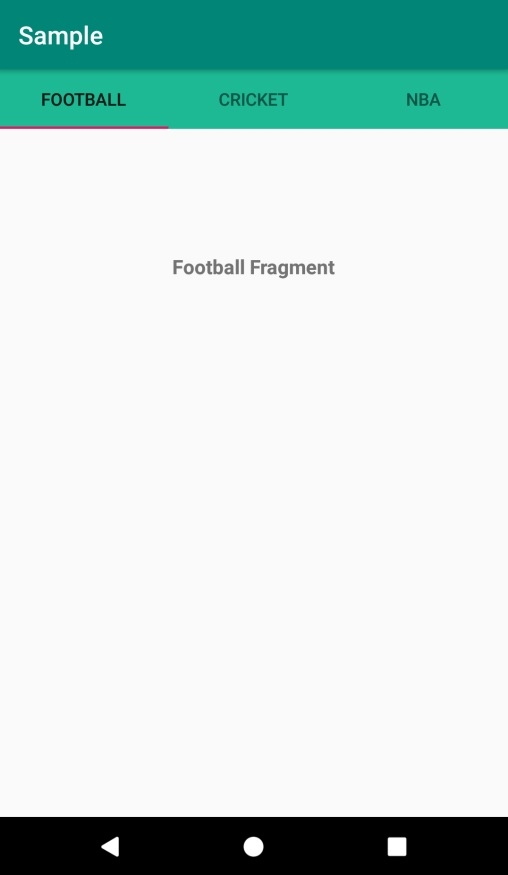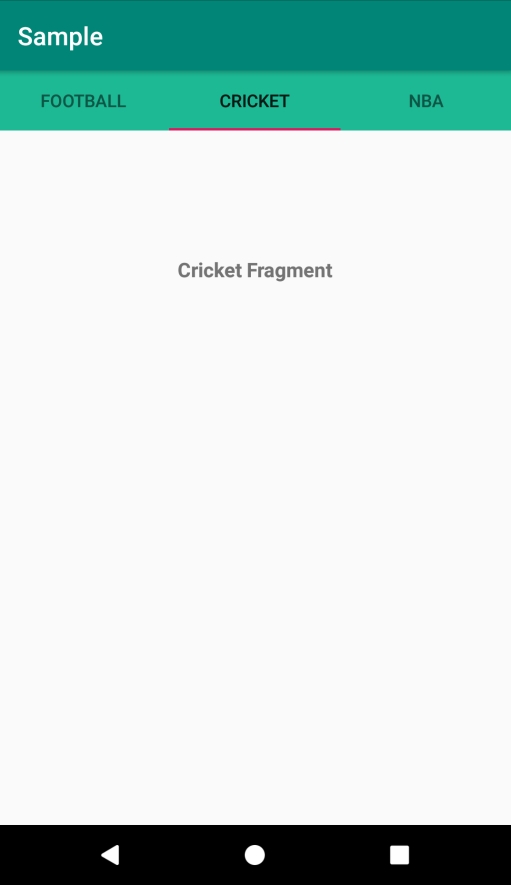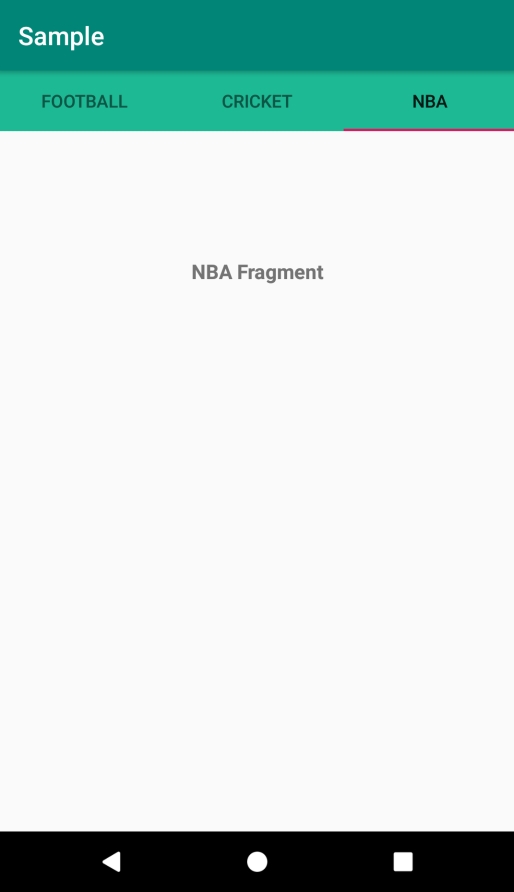
 Data Structure
Data Structure Networking
Networking RDBMS
RDBMS Operating System
Operating System Java
Java MS Excel
MS Excel iOS
iOS HTML
HTML CSS
CSS Android
Android Python
Python C Programming
C Programming C++
C++ C#
C# MongoDB
MongoDB MySQL
MySQL Javascript
Javascript PHP
PHP
- Selected Reading
- UPSC IAS Exams Notes
- Developer's Best Practices
- Questions and Answers
- Effective Resume Writing
- HR Interview Questions
- Computer Glossary
- Who is Who
How to Create a Tab Layout in Android App?
This example demonstrates how do I create a Tab Layout in android app.
Step 1 − Create a new project in Android Studio, go to File ⇒ New Project and fill all required details to create a new project.
Step 2 – Add the following dependency to create a tab layout −
implementation 'com.android.support:design:28.0.0'
Step 3 − Add the following code to res/layout/activity_main.xml.
<?xml version="1.0" encoding="utf-8"?> <RelativeLayout xmlns:android="http://schemas.android.com/apk/res/android" xmlns:tools="http://schemas.android.com/tools" android:layout_width="match_parent" android:layout_height="match_parent" tools:context=".MainActivity"> <android.support.design.widget.TabLayout android:id="@+id/tabLayout" android:layout_width="match_parent" android:layout_height="wrap_content" android:background="#1db995"> </android.support.design.widget.TabLayout> <android.support.v4.view.ViewPager android:id="@+id/viewPager" android:layout_width="wrap_content" android:layout_height="wrap_content" android:layout_below="@id/tabLayout" android:layout_centerInParent="true" android:layout_marginTop="100dp" tools:layout_editor_absoluteX="8dp" /> </RelativeLayout>
Step 4 − Add the following code to src/MainActivity.java
import android.support.v7.app.AppCompatActivity;
import android.os.Bundle;
import android.support.design.widget.TabLayout;
import android.support.v4.view.ViewPager;
public class MainActivity extends AppCompatActivity {
TabLayout tabLayout;
ViewPager viewPager;
@Override
protected void onCreate(Bundle savedInstanceState) {
super.onCreate(savedInstanceState);
setContentView(R.layout.activity_main);
tabLayout = findViewById(R.id.tabLayout);
viewPager = findViewById(R.id.viewPager);
tabLayout.addTab(tabLayout.newTab().setText("Football"));
tabLayout.addTab(tabLayout.newTab().setText("Cricket"));
tabLayout.addTab(tabLayout.newTab().setText("NBA"));
tabLayout.setTabGravity(TabLayout.GRAVITY_FILL);
final MyAdapter adapter = new MyAdapter(this,getSupportFragmentManager(),
tabLayout.getTabCount());
viewPager.setAdapter(adapter);
viewPager.addOnPageChangeListener(new TabLayout.TabLayoutOnPageChangeListener(tabLayout));
tabLayout.addOnTabSelectedListener(new TabLayout.OnTabSelectedListener() {
@Override
public void onTabSelected(TabLayout.Tab tab) {
viewPager.setCurrentItem(tab.getPosition());
}
@Override
public void onTabUnselected(TabLayout.Tab tab) {
}
@Override
public void onTabReselected(TabLayout.Tab tab) {
}
});
}
}
Step 5 – Create a java class(MyAdapter.java) and add the following code −
import android.content.Context;
import android.support.v4.app.Fragment;
import android.support.v4.app.FragmentPagerAdapter;
import android.support.v4.app.FragmentManager;
class MyAdapter extends FragmentPagerAdapter {
Context context;
int totalTabs;
public MyAdapter(Context c, FragmentManager fm, int totalTabs) {
super(fm);
context = c;
this.totalTabs = totalTabs;
}
@Override
public Fragment getItem(int position) {
switch (position) {
case 0:
Football footballFragment = new Football();
return footballFragment;
case 1:
Cricket cricketFragment = new Cricket();
return cricketFragment;
case 2:
NBA nbaFragment = new NBA();
return nbaFragment;
default:
return null;
}
}
@Override
public int getCount() {
return totalTabs;
}
}
Step 6 – Now create the fragments and the layouts (Right click on the project >> New >> Fragment >> Blank −
a) FootBall.java
import android.os.Bundle;
import android.support.v4.app.Fragment;
import android.view.LayoutInflater;
import android.view.View;
import android.view.ViewGroup;
public class Football extends Fragment {
public Football() {
// Required empty public constructor
}
@Override
public View onCreateView(LayoutInflater inflater, ViewGroup container,
Bundle savedInstanceState) {
return inflater.inflate(R.layout.fragment_football, container, false);
}
}
fragment_football.xml
<?xml version="1.0" encoding="utf-8"?> <FrameLayout xmlns:android="http://schemas.android.com/apk/res/android" xmlns:tools="http://schemas.android.com/tools" android:layout_width="match_parent" android:layout_height="match_parent" tools:context=".Football"> <!-- TODO: Update blank fragment layout --> <TextView android:layout_width="match_parent" android:layout_height="match_parent" android:textAlignment="center" android:text="Football Fragment" android:textSize="16sp" android:textStyle="bold"/> </FrameLayout>
b) Cricket.java
import android.os.Bundle;
import android.support.v4.app.Fragment;
import android.view.LayoutInflater;
import android.view.View;
import android.view.ViewGroup;
public class Cricket extends Fragment {
public Cricket() {
// Required empty public constructor
}
@Override
public View onCreateView(LayoutInflater inflater, ViewGroup container,
Bundle savedInstanceState) {
return inflater.inflate(R.layout.fragment_cricket, container, false);
}
}
fragment_cricket.xml
<?xml version="1.0" encoding="utf-8"?> <FrameLayout xmlns:android="http://schemas.android.com/apk/res/android" xmlns:tools="http://schemas.android.com/tools" android:layout_width="match_parent" android:layout_height="match_parent" tools:context=".Cricket"> <TextView android:layout_width="match_parent" android:layout_height="match_parent" android:textAlignment="center" android:text="Cricket Fragment" android:textSize="16sp" android:textStyle="bold"/> </FrameLayout>
c) NBA.java
import android.os.Bundle;
import android.support.v4.app.Fragment;
import android.view.LayoutInflater;
import android.view.View;
import android.view.ViewGroup;
public class NBA extends Fragment {
public NBA() {
// Required empty public constructor
}
@Override
public View onCreateView(LayoutInflater inflater, ViewGroup container,
Bundle savedInstanceState) {
return inflater.inflate(R.layout.fragment_nb, container, false);
}
}
fragment_nba.xml
<?xml version="1.0" encoding="utf-8"?> <FrameLayout xmlns:android="http://schemas.android.com/apk/res/android" xmlns:tools="http://schemas.android.com/tools" android:layout_width="match_parent" android:layout_height="match_parent" tools:context=".NBA"> <!-- TODO: Update blank fragment layout --> <TextView android:layout_width="match_parent" android:layout_height="match_parent" android:textAlignment="center" android:text="NBA Fragment" android:textSize="16sp" android:textStyle="bold"/> </FrameLayout>
Step 7 - Add the following code to androidManifest.xml
<?xml version="1.0" encoding="utf-8"?> <manifest xmlns:android="http://schemas.android.com/apk/res/android" package="app.com.sample"> <application android:allowBackup="true" android:icon="@mipmap/ic_launcher" android:label="@string/app_name" android:roundIcon="@mipmap/ic_launcher_round" android:supportsRtl="true" android:theme="@style/AppTheme"> <activity android:name=".MainActivity"> <intent-filter> <action android:name="android.intent.action.MAIN" /> <category android:name="android.intent.category.LAUNCHER" /> </intent-filter> </activity> </application> </manifest>
Let's try to run your application. I assume you have connected your actual Android Mobile device with your computer. To run the app from android studio, open one of your project's activity files and click Run ![]() icon from the toolbar. Select your mobile device as an option and then check your mobile device which will display your default screen –
icon from the toolbar. Select your mobile device as an option and then check your mobile device which will display your default screen –



Click here to download the project code.

